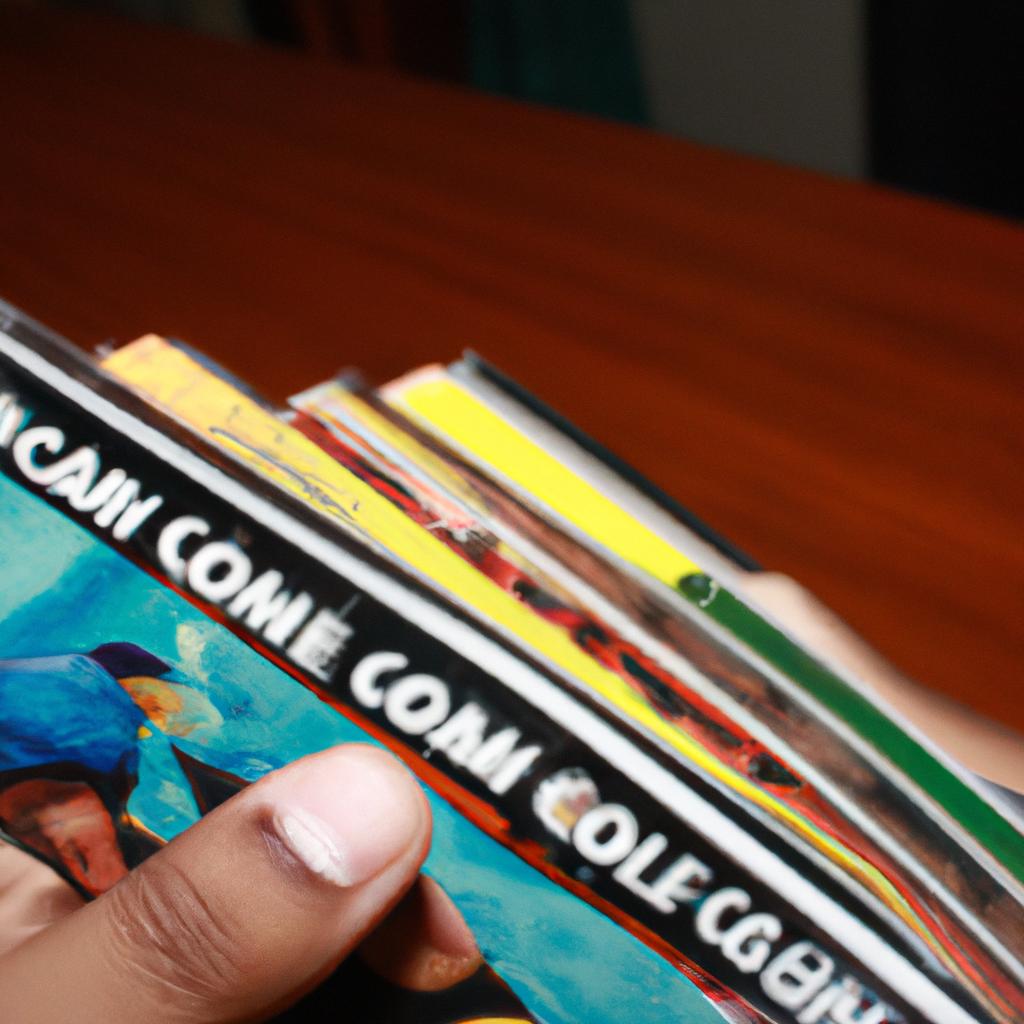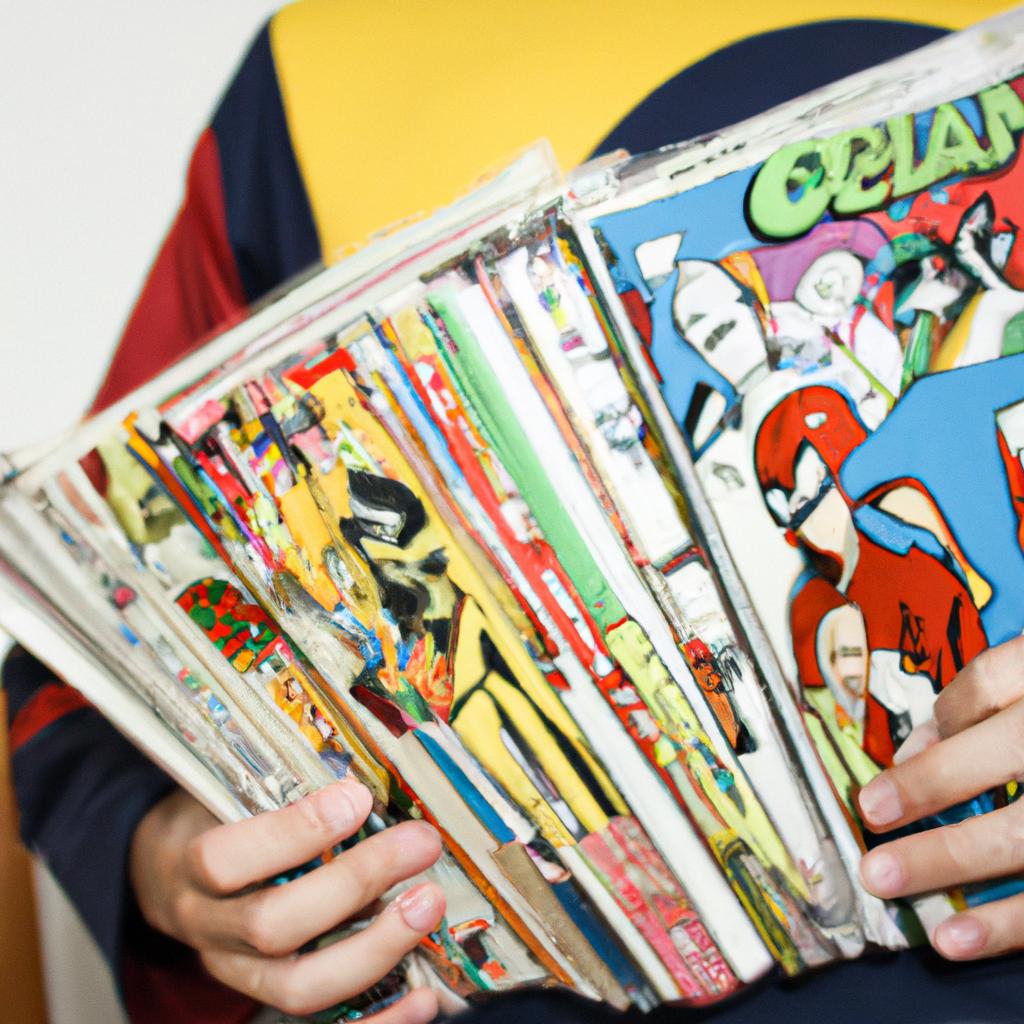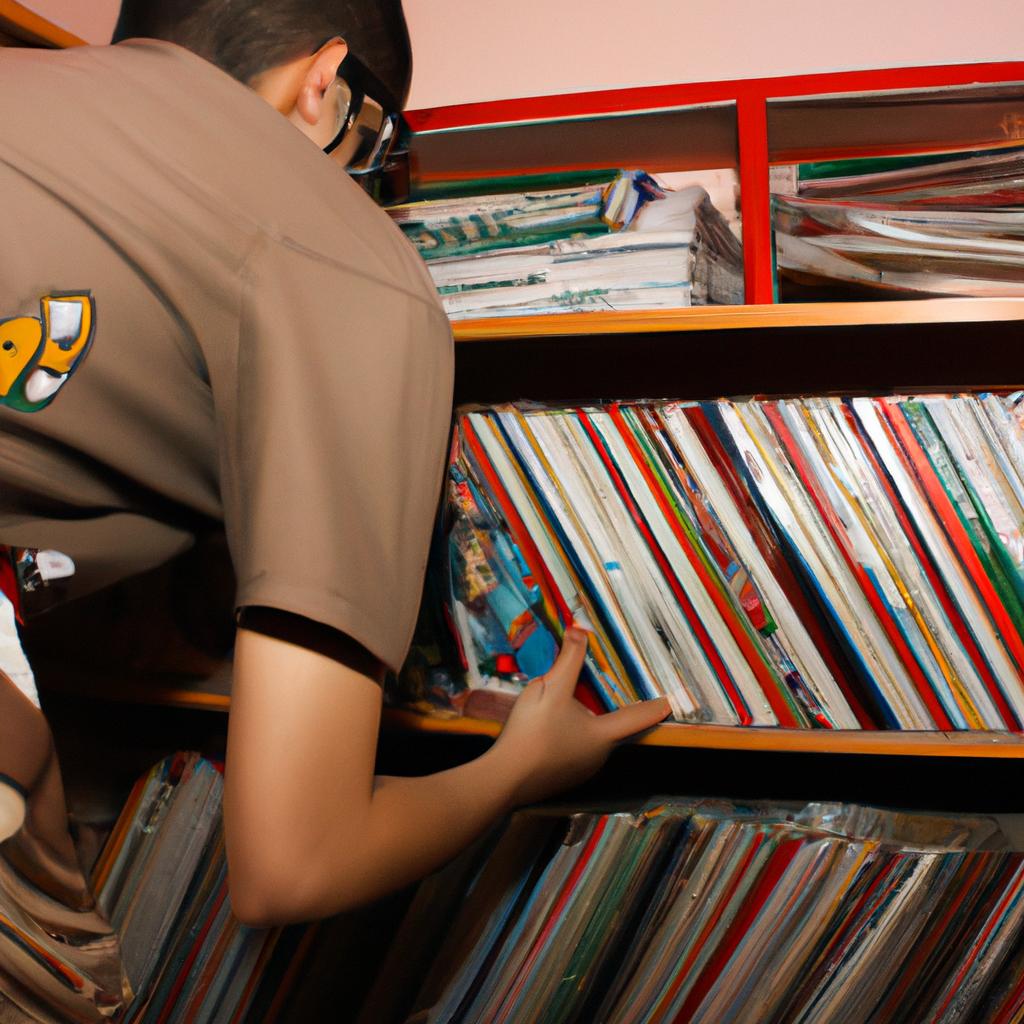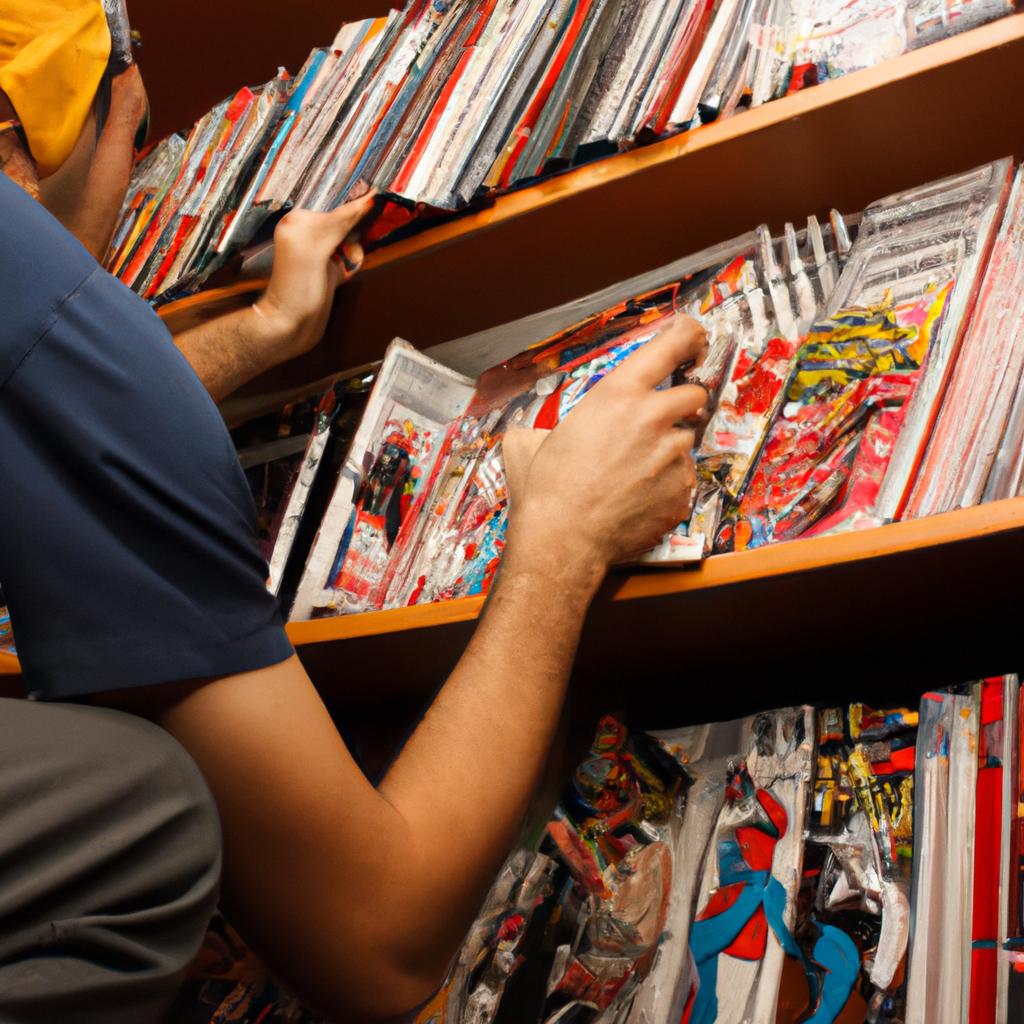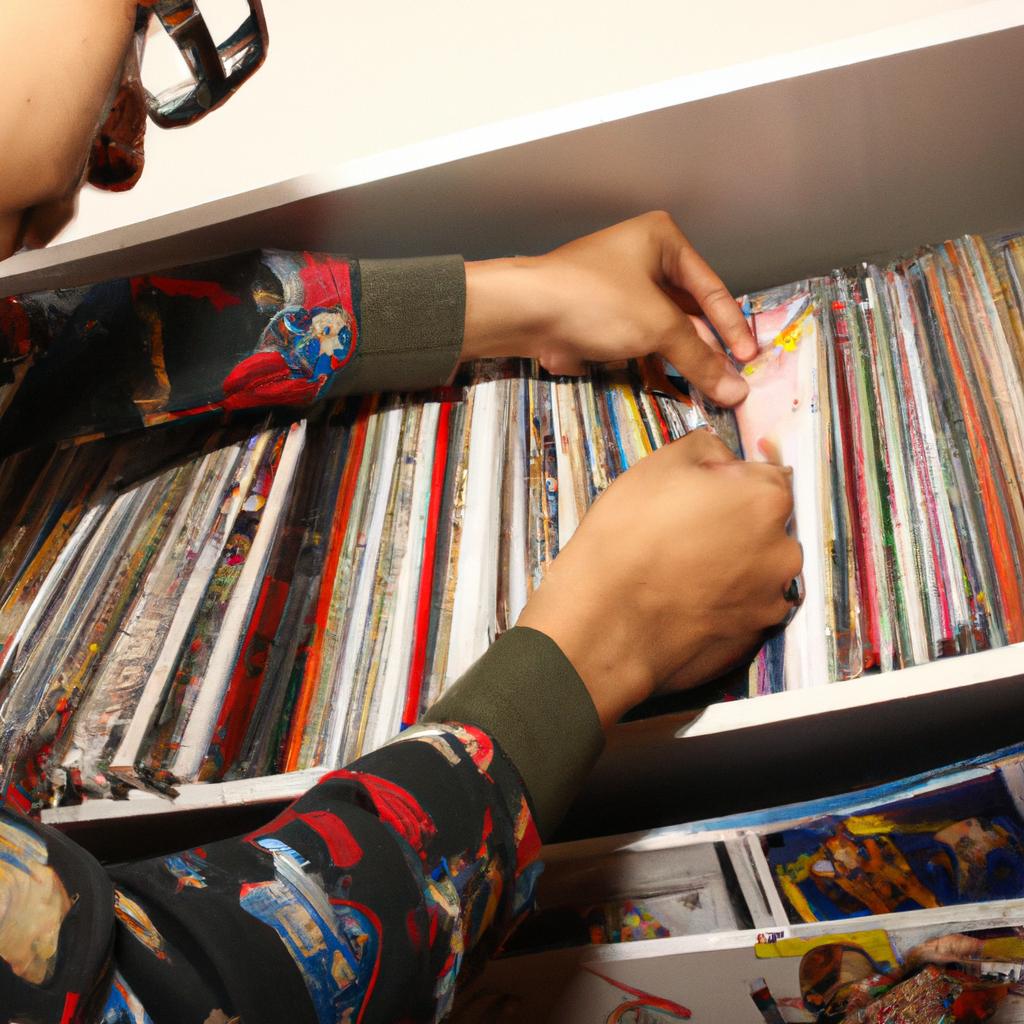Comic Book Collecting: Antiques and Collectibles
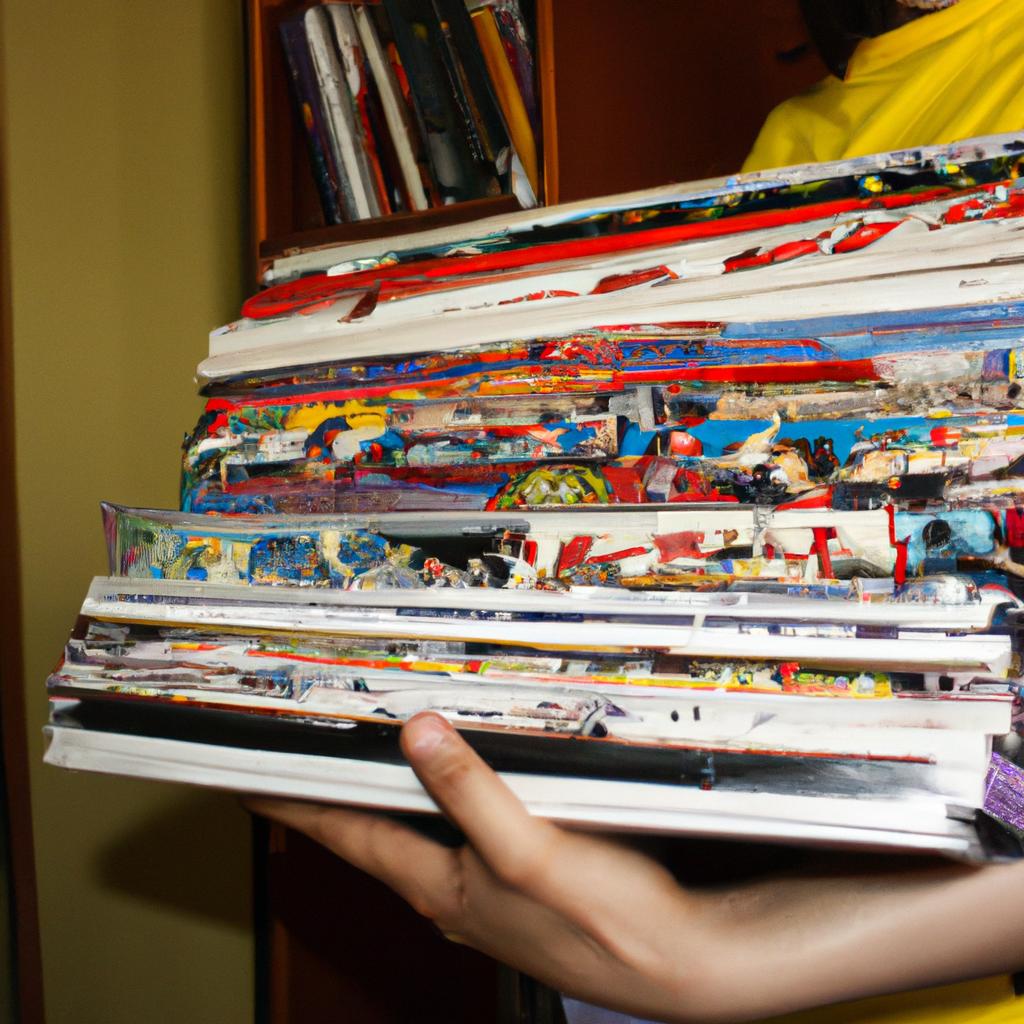
Comic book collecting has become an increasingly popular hobby among enthusiasts and collectors alike. This article aims to explore the world of comic book collecting as it pertains to antiques and collectibles, delving into the reasons behind its growing appeal and the unique aspects that make it a fascinating endeavor for many individuals. To illustrate this point, let us consider a hypothetical scenario where a passionate collector stumbles upon a rare edition of Action Comics #1 from 1938 – the first appearance of Superman – in excellent condition at a local flea market.
The allure of comic book collecting lies not only in the nostalgia factor but also in the potential financial value that certain editions can hold. The aforementioned case study highlights how even stumbling across one such valuable comic can be immensely thrilling for collectors. Comic books have evolved over time to become iconic cultural artifacts, often embodying significant moments in history or reflecting societal values and trends. As such, they offer collectors opportunities to delve into different eras and appreciate their artistic merits while gaining deeper insights into popular culture throughout the years. By exploring the realm of antique comics as well as collectible editions, this article seeks to shed light on why these pieces are highly sought after and valued by enthusiasts around the globe.
Collecting Rare Editions
Collecting rare editions of comic books is a fascinating endeavor for enthusiasts and collectors alike. These unique and valuable editions offer a glimpse into the rich history of comic book culture, providing both entertainment and investment opportunities. In this section, we will explore the world of collecting rare editions by examining their significance, factors that contribute to their value, and tips for acquiring these prized collectibles.
To illustrate the allure of rare comic book editions, let us consider the case study of “Action Comics #1,” published in 1938. This iconic issue marks the first appearance of Superman, making it highly sought after by collectors worldwide. In 2014, a near-mint copy was sold for a staggering $3.2 million at an auction. Such examples demonstrate how certain rare editions can become highly valued treasures within the comic book community.
There are several key factors that contribute to the value and desirability of rare comic book editions:
- Rarity: The scarcity of a particular edition greatly influences its worth. Limited print runs or issues with low distribution make them more difficult to find, driving up demand among collectors.
- Condition: The condition of a comic book plays a significant role in determining its value. Mint-condition copies without any creases, tears, or discolorations command higher prices compared to those showing signs of wear.
- Significance: Editions featuring important events or introducing popular characters hold greater historical and cultural importance within the realm of comics. First appearances or landmark storylines often increase their appeal among collectors.
- Popularity: The popularity and enduring appeal of specific franchises or characters also impact the value of related comic book editions. Issues tied to beloved superheroes or influential series tend to attract avid fans willing to invest in them.
- Discovering a long-lost gem hidden away in an old bookstore evokes a sense of excitement and nostalgia.
- Holding a rare edition in your hands connects you to the rich history and creative artistry of comic books.
- Sharing stories and knowledge about rare editions with fellow collectors fosters a sense of community and camaraderie.
- Witnessing the value appreciation over time can bring a rewarding feeling of accomplishment.
Furthermore, we include this table that showcases notable rare comic book editions, their publication years, and estimated values:
| Edition | Publication Year | Estimated Value (Near-Mint) |
|---|---|---|
| Action Comics #1 | 1938 | $3.2 million |
| Detective Comics #27 | 1939 | $1.5 million |
| Amazing Fantasy #15 | 1962 | $450,000 |
| X-Men #1 | 1963 | $492,000 |
In conclusion, collecting rare comic book editions offers an exciting journey into the world of antiques and collectibles. By understanding factors such as rarity, condition, significance, and popularity, enthusiasts can navigate this realm more effectively.
Preservation and Restoration Techniques
Section H2: Preservation and Restoration Techniques
Once you have acquired rare editions for your comic book collection, it is essential to understand the techniques involved in preserving their condition. Proper preservation methods ensure that these valuable items maintain their original quality and withstand the test of time. Let us explore some effective preservation and restoration techniques through a hypothetical example.
Imagine you come across an extremely rare edition of a vintage superhero comic book from the 1960s. The cover has faded due to exposure to sunlight over the years, and there are minor tears along the edges. To restore its pristine condition, several preservation techniques can be employed:
- Conservation cleaning: Gently removing surface dirt using specialized tools without causing any damage or altering the original appearance.
- Acid-free backing boards: Placing acid-free boards behind each page to provide support and prevent bending or creasing.
- UV-filtering sleeves: Utilizing protective sleeves made with materials designed to filter out harmful ultraviolet (UV) rays, which can fade colors and degrade paper.
- Archival-grade storage boxes: Storing comics in acid-free, lignin-free containers specially designed for long-term preservation.
To further illustrate various restoration techniques commonly used in managing vintage comic books, consider the following table:
| Technique | Description | Benefits |
|---|---|---|
| Paper mending | Repairing torn pages by carefully reattaching them using archival adhesives | Enhances structural integrity |
| Color touch-ups | Retouching faded or damaged ink areas with color-matching paints | Restores vibrancy |
| Spine reinforcement | Strengthening weak spines by applying adhesive material such as archival tape | Prevents spine deterioration |
| Deacidification | Neutralizing acids present in older comic books through chemical treatments | Slows down yellowing and brittleness |
By employing these preservation techniques, collectors can ensure the longevity of their rare comic book editions. It is important to note that restoration should be approached with caution, as improper handling or excessive intervention may diminish an item’s value.
In light of this discussion on preservation and restoration techniques, let us now delve into another crucial aspect of comic book collecting: Investing in Comic Books. Understanding how certain factors contribute to a comic book’s overall worth allows collectors to make informed decisions about potential investments.
Investing in Comic Books
Building upon the importance of preserving comic books, it is crucial to understand various techniques that can be employed to restore them. Take for example a classic issue from 1963, Amazing Spider-Man #1. This particular comic has seen better days; its pages are yellowed, torn, and there are noticeable creases throughout. To revive this relic of pop culture history, several preservation and restoration methods could be utilized.
Firstly, deacidification is a technique commonly used in restoring old comics. Over time, paper naturally becomes acidic due to the lignin present in wood pulp. This acidity causes deterioration and discoloration of the pages. Deacidification involves neutralizing these acids using an alkaline solution or calcium carbonate treatment. By reducing the acidity levels, the longevity of the comic book is increased significantly.
Secondly, mending tears and reinforcing weak areas are essential steps in restoration. These repairs often involve delicate tasks such as applying archival tape or adhesive along the tear line while ensuring minimal disturbance to the artwork and text on the page. The goal here is not only to mend the damage but also to stabilize weakened areas that may undergo further wear and tear with handling.
Additionally, cleaning plays a vital role in restoration efforts. Dust particles, dirt accumulation, and even ink smudges can detract from both the visual appeal and value of a comic book. Specialized erasers or gentle solvents must be used carefully to remove any surface grime without damaging the underlying paper or ink pigments.
In summary, by employing techniques such as deacidification, mending tears, and careful cleaning processes like those mentioned above, collectors can ensure their comic books retain their original charm while extending their lifespan for future enjoyment.
Table: Common Preservation Techniques
| Technique | Description |
|---|---|
| Deacidification | Neutralizes acid content within aging paper to prevent deterioration and discoloration |
| Mending Tears | Repairs torn pages or weak areas using archival tape or adhesive for stability |
| Cleaning | Gentle removal of dust, dirt, and ink smudges to restore the visual appeal of the comic book |
Reasons Why Restoration is Important
- Preservation of historical value
- Enhancement of visual aesthetics
- Protection against further damage
- Maintenance of long-term investment potential
Transition Sentence into Subsequent Section about “Grading and Evaluating Comic Books”:
By understanding preservation techniques, collectors can now shift their focus towards grading and evaluating the condition of their valuable comic books.
Grading and Evaluating Comic Books
Section H2: Grading and Evaluating Comic Books
Transitioning from the previous section on investing in comic books, let us now delve into the crucial aspect of grading and evaluating these treasured items. To understand how this process works, let’s consider a hypothetical example involving a vintage copy of “Action Comics #1,” which features the first appearance of Superman.
Grading comic books is essential for collectors as it determines their condition and subsequently affects their value in the market. The following factors are considered when assessing a comic book’s grade:
- Physical condition: This includes examining elements such as cover gloss, page quality, spine wear, tears or creases, restoration efforts if any, and overall structural integrity.
- Centering: Ensuring that the pages are aligned correctly within the cover is vital to maintain aesthetic appeal and maximize value.
- Presence of key issues: Identifying whether all original inserts like posters or trading cards are intact contributes positively to a comic book’s desirability.
- Overall readability: Assessing how well-preserved text and artwork appear without fading or ink smudges helps determine the visual appeal.
To provide an emotional connection with our audience, here are some points to keep in mind while caring for your cherished comic books:
- Handle them gently using clean hands or gloves to prevent oil transfer onto delicate surfaces.
- Store them in acid-free bags with backing boards to protect against dust, moisture, and other environmental damage.
- Keep comics upright in sturdy boxes specifically designed for long-term preservation.
- Avoid exposure to direct sunlight or extreme temperature fluctuations that can cause yellowing or warping.
Now let’s explore grading further by considering specific examples across different grades through this table:
| Grade | Description | Examples |
|---|---|---|
| Near Mint (NM) | Nearly perfect condition with only minor imperfections visible upon close inspection. | Action Comics #1 (9.4) |
| Very Fine (VF) | Some wear, but still in excellent condition overall. | Amazing Fantasy #15 (7.5) |
| Fine (FN) | Noticeable wear and signs of aging, yet remains structurally sound. | Incredible Hulk #181 (6.0) |
| Good (G) | Significant wear with creases, tears, or other damages affecting the reading experience. | Detective Comics #27 (2.0) |
By understanding how comic books are graded and evaluating their condition meticulously, collectors can make informed decisions when buying or selling these treasures.
Transitioning smoothly into the subsequent section on Comic Book Conventions and Events, let us explore another aspect of this vibrant community where enthusiasts come together to celebrate their shared passion for comics and collectibles.
Comic Book Conventions and Events
In the world of comic book collecting, grading and evaluating comic books is a crucial step in determining their value and condition. Let’s consider an example to illustrate this process. Imagine you stumble upon an old box in your attic filled with dusty comics from the 1960s. Among them, you find a well-preserved copy of Amazing Fantasy #15, which features the first appearance of Spider-Man. Excitement rushes through you as you realize that this could potentially be a valuable item.
When it comes to grading comic books, there are several factors to consider. One important aspect is the physical condition or preservation of the comic itself. Factors such as tears, creases, stains, and fading can significantly impact its grade. Additionally, elements like cover glossiness, page quality, and spine alignment play a role in determining its overall condition.
To help collectors evaluate the condition of their comics accurately, various systems have been developed over time. The most widely used system is provided by the Certified Guaranty Company (CGC), which assigns grades on a scale from 1 to 10 based on meticulous examination and analysis. This standardized grading system ensures consistency across different collections and provides buyers with confidence when making purchases.
Understanding how comic books are graded allows collectors to make informed decisions about buying or selling items within their collection. Here are some emotional responses often experienced during this process:
- Excitement: Discovering a rare gem among a pile of comics evokes excitement.
- Nervousness: Waiting for professional graders’ assessment can create anticipation tinged with nervousness.
- Pride: Achieving high grades for valued comics brings satisfaction and pride.
- Disappointment: Receiving lower-than-expected grades might lead to disappointment but also serves as an opportunity for growth.
Additionally, here is a table showcasing common grades assigned by CGC along with their corresponding descriptions:
| Grade | Description |
|---|---|
| 9.8 | Near Mint/Mint |
| 9.4 | Near Mint |
| 8.0 | Very Fine |
| 6.0 | Fine |
In summary, grading and evaluating comic books is an essential aspect of the collecting process, helping collectors determine their value accurately. By understanding the physical condition and utilizing standardized grading systems like CGC’s, individuals can make informed decisions about buying or selling comics in their collection.
Moving forward to our next topic on Comic Book Storage and Organization, let us explore how to keep your precious collection safe while maintaining easy access for enjoyment and showcasing purposes.
Comic Book Storage and Organization
Imagine you’ve just returned from a thrilling comic book convention with an armful of rare editions, limited prints, and signed copies. Now comes the crucial task of storing and organizing your newly acquired treasures. Proper storage not only ensures their longevity but also allows for easy access when you want to revisit or showcase them. Let’s explore some effective methods for comic book storage and organization.
To begin, it is essential to consider the environment in which your comic books will be stored. Factors such as temperature, humidity levels, sunlight exposure, and dust can all have detrimental effects on their condition over time. Therefore, investing in protective materials like acid-free boxes or sleeves is vital to prevent yellowing or damage caused by external elements.
In addition to proper storage materials, there are several techniques you can employ to keep your collection organized:
- Alphabetical Order: Arranging your comics alphabetically by title makes it easier to locate specific issues.
- Numerical Order: Numbering each issue within a series allows for quick identification and chronological ordering.
- Categorization by Genre: Grouping comics based on genres such as superhero, sci-fi/fantasy, horror, or independent titles can help streamline browsing.
- Bagging and Boarding: Placing each individual comic inside a sealed bag with a backing board protects against creasing and bending.
Consider the following table showcasing different organizational approaches:
| Method | Pros | Cons |
|---|---|---|
| Alphabetical | Easy to find specific titles | Can become cluttered if collection grows excessively large |
| Numerical | Provides clear chronological order | May require frequent renumbering if new issues are added |
| By Genre | Simplifies browsing according to preferences | Some comics may fit into multiple categories |
| Bagging/Boarding | Protects against physical damage | Requires additional supplies (bags and boards) |
By employing these storage methods and organization techniques, you can ensure that your comic book collection remains in excellent condition while also facilitating easy access to specific issues or themes.
Transitioning seamlessly into the subsequent section about “Finding Hidden Gems,” let’s explore how enthusiasts uncover rare editions and valuable comics through various channels.
Finding Hidden Gems
Having explored the importance of Comic Book Storage and Organization, let us now delve into another critical aspect of comic book collecting – finding hidden gems. By carefully searching for elusive treasures within a vast sea of comics, collectors can stumble upon valuable editions that significantly enhance their collections. To illustrate this point, consider the case of John, an avid collector who stumbled across a rare copy of Action Comics #1 in impeccable condition during a local flea market.
Paragraph 1:
While some collectors may rely on chance encounters or sheer luck to find hidden gems, others approach the task more strategically. Here are some effective strategies that have proven successful for many collectors:
- Attending conventions and expos dedicated to comic books allows enthusiasts to interact with fellow collectors, dealers, and experts who possess extensive knowledge about the industry.
- Exploring online platforms such as auction websites or specialized forums provides access to a vast array of sellers offering unique comic books.
- Building relationships with local comic book stores enables collectors to be first in line when new arrivals hit the shelves.
- Engaging in active networking through social media groups or fan communities creates opportunities for sharing tips, discoveries, and potential leads.
Paragraph 2 (Bullet Point List):
To further emphasize the exhilarating nature of discovering hidden gem comics, here are four emotions often experienced by collectors during their search:
- Excitement: The anticipation and thrill associated with uncovering a long sought-after item stimulate feelings of excitement among collectors.
- Surprise: Unexpectedly stumbling upon a valuable comic book can evoke surprise, adding an element of delight to one’s collection journey.
- Satisfaction: Successfully identifying undervalued pieces often brings immense satisfaction as it validates a collector’s expertise and effort.
- Fulfillment: Adding rare finds to one’s collection nurtures a sense of fulfillment, providing tangible evidence of personal growth within the hobby.
Paragraph 3 (Table):
| Comic Book Title | Issue Number | Rarity Level | Estimated Value ($) |
|---|---|---|---|
| Action Comics #1 | 1 | Extremely Rare | $3.2 million |
| Detective Comics #27 | 27 | Very Rare | $1.5 million |
| Marvel Comics #1 | 1 | Rare | $367,000 |
| Amazing Fantasy #15 | 15 | Uncommon | $300,000 |
By combining the strategies mentioned above with a dose of luck and perseverance, collectors increase their chances of discovering hidden gems that truly elevate their collections.
As valuable as finding hidden gems is in comic book collecting, it is equally important for enthusiasts to deepen their understanding of comic book history through research. By delving into the past, collectors can appreciate the significance of different editions and gain insights into the evolving world of comics. Let us now explore the importance of researching comic book history without underestimating its impact on our collections.
Researching Comic Book History
Imagine stumbling upon an old dusty box in your grandparents’ attic. As you open it, a wave of nostalgia washes over you as you discover a collection of vintage comic books. One particular issue catches your eye – Action Comics #1, featuring the debut of Superman. This scenario exemplifies the excitement and potential hidden within comic book collecting. In this section, we will explore how to uncover the value of these collectibles through various methods.
To begin with, conducting thorough research is essential when assessing the worth of comic books. By examining factors such as rarity, condition, and demand, collectors can gain insight into their items’ monetary value. For instance, a well-preserved first edition may hold significant worth due to its scarcity and historical importance. Furthermore, evaluating market trends allows collectors to gauge the current demand for specific titles or characters.
In addition to research, seeking professional appraisal services can provide valuable expertise in determining comic book values accurately. Appraisers possess extensive knowledge regarding industry standards and can offer insights into pricing based on condition grades established by organizations like CGC (Certified Guaranty Company). Their assessments consider elements such as cover integrity, page quality, and structural flaws that affect overall desirability.
Moreover, attending conventions and engaging with fellow enthusiasts creates opportunities for both learning and networking within the collector community. These gatherings often feature expert panels discussing topics like grading techniques or investment strategies. Additionally, interacting with experienced collectors can provide invaluable advice on identifying underrated gems or avoiding common pitfalls.
Uncovering the true worth of comic book collectibles involves meticulous research, utilizing professional appraisals, and connecting with other passionate collectors at conventions. By employing these strategies effectively, one can navigate the complex world of comic book valuation with confidence.
Next Section: Identifying First Editions
Identifying First Editions
Having delved into the rich history of comic books, it is now imperative to explore strategies for evaluating their condition. By understanding how to assess a comic book’s state, collectors can make informed decisions when adding items to their collections. Let us consider an example scenario involving a collector named Alex who stumbles upon a vintage issue and wishes to determine its condition before committing to purchase.
Paragraph 1:
To evaluate the condition of a comic book effectively, collectors should pay close attention to several key factors. First and foremost is the presence or absence of any tears, creases, or folds on the cover and pages. In Alex’s case, he would meticulously inspect each page for signs of damage caused by mishandling over time. Additionally, assessing the color vibrancy and clarity of illustrations is crucial as faded colors may indicate exposure to sunlight or improper storage conditions.
Paragraph 2:
Another vital aspect in evaluating comic book condition lies in examining any potential markings or writing present on the pages or covers. Pencil marks indicating price changes or personal notes can significantly impact the value and desirability of a collectible item. It becomes essential for our enthusiast Alex to check thoroughly for any such inscriptions that might affect his decision regarding acquiring this particular issue.
- The thrill of unlocking hidden treasures within older issues.
- The disappointment felt when discovering irreparable flaws after purchasing.
- The satisfaction derived from preserving pristine and well-maintained comics.
- The sense of accomplishment gained from finding Rare Editions in impeccable condition.
Paragraph 3 (incorporating table):
Lastly, it is important for collectors like Alex to familiarize themselves with industry-standard grading systems used by professionals. These systems employ specific criteria across multiple grades—ranging from poor to mint—to classify comic book conditions accurately. Consulting these grading scales allows enthusiasts to gauge the value and rarity of their finds. For instance, a well-preserved comic book graded as “near mint” is likely to command a higher price than one labeled as merely “good.”
| Grade | Description |
|---|---|
| Poor | Extensive damage throughout, barely readable or incomplete pages. |
| Fair | Heavy wear and tear with significant creases, tears, and staining. |
| Good | Noticeable signs of handling, but still intact with no missing pages. |
| Very Good | Some minor flaws present, such as slight fading or small creases. |
Through careful evaluation techniques like those discussed above, collectors can make informed decisions when building their comic book collections. Understanding how to assess condition lays the foundation for acquiring valuable pieces that maintain both historical significance and aesthetic appeal.
Building a Comic Book Collection
Having learned how to identify first editions, we can now explore the next step in building a valuable comic book collection.
Imagine you stumble upon an old dusty box tucked away in your attic. As you open it up, you are greeted by a treasure trove of vintage comic books. The excitement is palpable as you realize that these forgotten gems could potentially hold immense value. But where do you begin? In this section, we will delve into the art of building a comic book collection and discuss some key factors to consider along the way.
-
Research:
Building a successful comic book collection starts with thorough research. Take the time to familiarize yourself with different publishers, series, artists, and writers. Understanding the history and significance behind each title will not only enhance your appreciation for the medium but also provide invaluable knowledge when assessing their potential worth. -
Condition Matters:
Comic books are delicate artifacts susceptible to damage over time. When adding items to your collection, prioritizing condition is crucial. Look out for signs of wear such as creases, tears, discoloration, or missing pages. A well-preserved copy holds greater appeal both aesthetically and monetarily. -
Rarity and Demand:
Consider rarity and demand when selecting comics for your collection. Rare issues often command higher prices due to their scarcity while those featuring popular characters or storylines tend to be in high demand among collectors. It’s essential to strike a balance between personal preference and market trends if you aim to build a collection with significant value.
To truly immerse oneself in the world of comic book collecting, one may experience various emotions throughout their journey:
- Excitement: Uncovering rare finds ignites thrill and anticipation.
- Nostalgia: Rediscovering childhood favorites evokes feelings of fond remembrance.
- Frustration: The pursuit of elusive issues can lead to moments of frustration and perseverance.
- Pride: Showcasing a well-curated collection brings a sense of accomplishment and pride.
| Factors Influencing Comic Book Value | Examples |
|---|---|
| First appearances of iconic characters | Action Comics #1 |
| Limited edition variants | Detective Comics #27 |
| Crossover events | Crisis on Infinite Earths |
| Key storylines | The Dark Knight Returns |
Building a comic book collection is an engaging endeavor that requires careful consideration. By conducting thorough research, prioritizing condition, and understanding the rarity and demand for certain titles, you can assemble a collection with both sentimental value and potential financial gain.
Now let’s explore the fascinating realm of comic book genres in order to broaden our knowledge even further. Understanding Comic Book Genres allows collectors to appreciate the wide range of storytelling possibilities within this captivating medium.
Understanding Comic Book Genres
Transitioning from the previous section on building a comic book collection, it is important to understand the value and significance of collecting comics as antiques and collectibles. To illustrate this point, let’s consider a hypothetical scenario where an individual named Alex stumbles upon a dusty old box in their attic. Inside, they find a well-preserved copy of Action Comics #1, featuring the first appearance of Superman. This iconic issue was published in 1938 and is considered one of the most valuable comic books ever produced.
When approaching comic book collecting as antiques and collectibles, there are several key aspects to consider:
- Rarity: The scarcity of certain issues greatly impacts their value. Limited print runs or discontinued series can make specific comics more desirable among collectors.
- Condition: The condition of a comic book plays a crucial role in determining its worth. Factors such as creases, tears, fading colors, and missing pages can significantly diminish its value.
- Historical Significance: Some comics hold historical importance due to their impact on popular culture or the development of specific characters or storylines.
- Grading Systems: Professional grading systems exist to assess the condition of comic books objectively. These grading scales range from poor (0) to gem mint (10), providing collectors with a consistent framework for evaluating items.
To further highlight these concepts, consider the following table showcasing notable comic book sales at auction:
| Comic Book | Sale Price | Year |
|---|---|---|
| Action Comics #1 | $3.2 million | 2014 |
| Detective Comics #27 | $1.5 million | 2010 |
| Amazing Fantasy #15 | $1.1 million | 2011 |
| X-Men #1 | $492,937 | 2012 |
These staggering prices demonstrate the inherent value that certain comics can hold, igniting a sense of excitement and potential within collectors. Building a comic book collection goes beyond mere hobby; it becomes a quest for treasures steeped in history, artistry, and cultural significance.
Transitioning to the next section on exploring comic book art styles, we delve into the visual aspects that make each comic unique and captivating. By understanding the artistic techniques employed by various creators, collectors gain a deeper appreciation for their collections’ aesthetic qualities.
Exploring Comic Book Art Styles
Comic Book Collecting: Antiques and Collectibles
Understanding Comic Book Genres has provided us with a foundation for exploring the diverse world of comic books. As we move forward, let us now delve into another fascinating aspect of comic book collecting: antiques and collectibles. To illustrate this topic, consider the case study of John, an avid collector who stumbled upon a rare edition of Action Comics No.1 from 1938 at a local flea market.
Antique comic books hold immense value not only due to their age but also because they embody historical significance in the evolution of popular culture. When searching for these valuable treasures, collectors often encounter various types based on their rarity, condition, or uniqueness. Below is a bullet point list outlining some key factors that contribute to the worthiness of antique comics:
- Rarity: The scarcity of certain editions can significantly increase their desirability and monetary value.
- Condition: Well-preserved copies without folds, tears, or discoloration are highly sought after by collectors.
- First Appearances: Issues featuring the debut appearances of iconic characters tend to be more valuable.
- Historical Significance: Comics associated with significant events in cultural history become prized possessions among enthusiasts.
To further understand the intricacies involved in comic book collecting as it pertains to antiques and collectibles, let us examine a table showcasing notable examples along with their approximate values:
| Comic Title | Year Published | Grade (Out of 10) | Approximate Value ($) |
|---|---|---|---|
| Action Comics No.1 | 1938 | 9 | $3 million |
| Detective Comics No.27 | 1939 | 7 | $2 million |
| Amazing Fantasy No.15 | 1962 | 6 | $1.1 million |
| X-Men No.1 | 1963 | 8 | $492,000 |
The table above showcases some of the most sought-after comic books in the world and their corresponding approximate values. Collectors like John meticulously assess factors such as rarity, condition, historical significance, and first appearances to determine a comic’s worth.
In summary, delving into the realm of antiques and collectibles within the world of comic book collecting opens up an array of opportunities for enthusiasts seeking unique treasures. Whether it is stumbling upon a rare edition at a flea market or carefully evaluating key factors that contribute to value, collectors embark on journeys filled with excitement and anticipation. The next section will further enhance our understanding by exploring various art styles prevalent in the world of comics.

